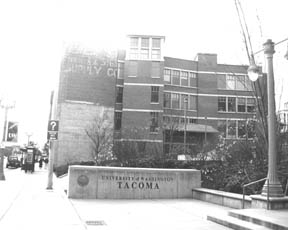A classroom in the Science Building on the campus of the University of Washington Tacoma was the setting of yesterdays Tacoma City Council study session.
The subject: the universitys current progress and future.
University representatives provided an overview of the campus history, new academic programs – particularly the Institute of Technology – and reviewed the campus Master Plan covering future use of the UW Tacomas 46-acre property.
Council members also heard about budget concerns that could affect the university.
HISTORY AND GROWTH
The establishment of UW Tacoma in 1990 was meant to accomplish two goals: satisfy state leaders who wanted to expand access to bachelors and masters degrees, and meet the needs of Tacoma leaders who wanted a university for economic development purposes.
Since its establishment in 1990, UW Tacoma – which moved to its current location from the Perkins Building in 1997 – has continued to grow.
Every year, we go up 50-to-100 students, Chancellor Vicky Carwein said of the increased number of UW Tacoma graduates every year.
UW opened in 1990 with 176 students, graduating its first class of four in spring 1991.
The university has a current enrollment of about 2,000 students, and this past Friday more than 650 students received degrees from UW Tacoma – the largest class ever by more than 100 students.
The total number of UW Tacoma graduates is about 4,000.
On average, UW Tacomas enrollment has gone up 15 percent every year, Carwein said.
The rate of growth here has been nothing short of phenomenal, she said. Without question, there are going to be enough students for all of us.
MASTER PLANNING UPDATE
To meet the demands of an increasing number of students, the university itself continues to grow in phases.
On hand to provide an update on the campus Master Plan and was UW Tacoma Project Manager Catherine Vogt of the Capital Projects Office.
UW Tacoma owns about 65 percent of the whole 46-acre property that is the site of the school, located in the heart of downtown Tacoma at 1900 Commerce St.
A portion of campus property is devoted to commercial and retail use.
Work is currently starting on Phase 2B of construction, the renovating of five historic warehouses – three Cherry Parkes buildings and two Mattress Factory buildings – along Pacific Avenue into classrooms, lab and office space, Vogt explained.
Phase 2A included the construction of the Science and Keystone Buildings, which opened in January.
The biggest change to the Master Plan, she said, is the opening of Fawcett Avenue and Jefferson Street through the downtown campus.
The university is also looking into the possibility of providing student housing, Vogt said.
We hope to wrap up final development of the Master Plan by December, she told the City Council.
UW Tacomas design has won two major national awards: a 1991 American Institute of Architects Award for Regional and Urban Design, for the universitys Master Plan and Phase I buildings, and a National Trust for Historic Preservation Honor Award.
INSTITUTE OF TECHNOLOGY
In 2001, the UW Tacomas Institute of Technology was launched, aimed at increasing the number of Washington residents with bachelors and masters degrees and certificates in high-technology fields.
We have to grow our own, said Larry Crum, Institute of Technology Director Larry Crum, referring to the professional workforce shortage in Washingtons technology industry.
The brainchild of Gov. Gary Locke, the UW Tacomas Institute of Technology is meant to address the technology industrys need for highly-educated workers, but is also meant to encourage people to enter the technology field and support them through education.
We see the institute as providing intellectual capital, Crum said.
Though graduates may initially leave the area, Crum said its hoped they will look for opportunities to return as downtown Tacoma continues to develop.
According to a 2001 Washington Software Alliance Workforce Study, there is a 2.3 to 1 ratio between job openings for software programmers/engineers and the available graduates produced by Washington universities to fill these openings.
The Institute of Technology offers high-tech learning in everything from programming languages to software engineering to emerging technologies.
The institute includes laboratories of specialized equipment that are open 24 hours a day, seven days a week to help support the program.
This was a public-private partnership from the start, Crum said. It needs to stay that way.
Barry Nilsen, a 35-year-old UW Tacoma senior in the Computing and Software Systems Program, said if it werent for the university, he wouldnt have gone back to school.
Nilsen said he, along with his wife, were reluctant to move from Tacoma to pursue opportunities in higher education, so UW Tacoma was a perfect fit.
Im very happy I came here, he said, adding that attending UW Tacoma has helped him to understand the value of a bachelors degree in the high-tech industry.
CHALLENGES AHEAD
With the state starting off the next biennium with a billion dollar deficit, Carwein said that could have a dramatic impact on UW Tacoma.
The expectation is that full-time enrollment (FTE) funds from the state will decrease, even as more students attend UW Tacoma, Carwein said.
Were not looking for any new programs in the next biennium, she said. I dont know whats going to happen statewide with FTEs.
Its possible that a significant number of students could be turned away from UW Tacoma in the future, she said, noting enrollment is up at universities across the state.
Im very concerned about that, Carwein said.
In addition to budget and funding concerns, UW Tacoma Advisory Board Member Herb Simon said the university must focus on retaining graduates by drawing the high-tech industry to Tacoma.
Were really proud of this institution, he said. Were just turning out great students. These are the students of the next generation.
Following the study session, Professor Cheryl Greengrove, environmental science, lead a tour of the Science Building.





